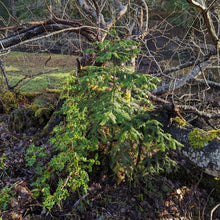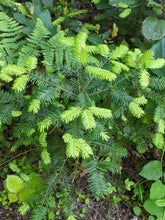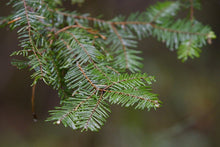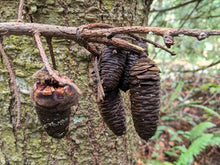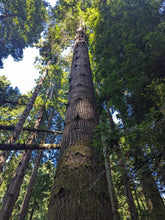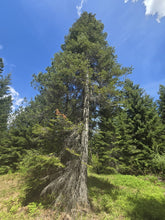
Abies grandis
Grand fir is a majestic evergreen tree that makes an excellent screen or windbreak, intercepts stormwater through evapotranspiration, provides erosion control, and supports insects and wildlife.
Birds, including hummingbirds, and mammals adore this tree for roosting, nesting, and foraging. It also supports beneficial, pest-eating insects! Its glossy blue-green needles are arranged in flat sprays on opposite sides of the twig and have a fragrant tangerine smell when crushed.
- Plant type/canopy layer: evergreen, perennial, overstory/large tree
- Size at maturity: 150-200' tall, 30-40' wide
- Light requirements: full sun, part-sun/part-shade, full shade
- Moisture requirements: prefers moist, well-drained soil but can tolerate dry to seasonably wet
- Bloom times: n/a
- Growth rate/ease: medium growth rate (grows more quickly, the more sun it receives), easy to grow
- Wildlife support: foliage is eaten by sapsuckers, woodpeckers, deer and elk; fir seeds are a preferred food source for chipmunks, squirrels, grouse, nuthatches, chickadees, grosbeaks, finches and crossbills; overall plant attracts and supports beneficial pest eating insects, is a hosts and larval food source for dozens of species of native moths and butterflies, including the pine white butterfly, and provides shelter to countless species of birds and many mammals such as squirrels, porcupines, and deer
- Native range: commonly found in mixed evergreen and coastal coniferous forests, from sea level to 1800 meters, along the coast from southern British Columbia to northern California, as well as east of the Cascades in Washington and northern Oregon and in the Rocky Mountains of Idaho and Montana. Portland Plant List - yes.
-
Special features & uses: evergreen; insect and wildlife favorite; landscape uses include erosion control, windbreaks and screens
- Materials use: the Kwakwaka'wakw shamans wove grand fir branches into head-dresses and costumes. The Hesquiat used the branches for incense and decorative clothing for wolf dancers. The Okanagan used the wood and bark to build canoes. The Salish used the bark to make a brown dye to apply to baskets. The knots in the wood were shaped, steamed, and carved into fish hooks by the Ditidaht, Salish, and other coastal groups. Pitch made from the bark's resin has been applied to bows and paddles to secure grip. (Washington Native Plant Society)
- Medicinal uses: The bark has been mixed with nettles to create a tonic and decoration for bathing. The Lushootseed have boiled its needles to make medicinal tea for colds. The Hesquiat mixed the pitch of young grand fir trees with oil and rubbed it on the scalp as a deodorant and to prevent balding. The bark has been mixed with other barks to make an infusion that was drunk to cure internal injuries. (Washington Native Plant Society)
Gardening with Grand Fir: Grand fir has lustrous boughs and grows in a near perfect pyramidal, Christmas tree shape - and fragrance as well. It can thrive with any amount of sunshine and prefers moist, sandy or loamy soils that are well-drained. It generally does not do well in heavy clay. That said, it can tolerate both dry and seasonable wet soil, especially if it gets some supplemental water in dry areas, during the summer, while becoming established. Be sure to provide this tree with plenty of room to grow, as its lower branches can reach up to 20' in diameter and it can reach a height of up to 250' in its long lifespan.
Try it in shady areas with deciduous trees like red alder (Alnus rubra) and vine maple (Acer circinatum), shrubs such as evergreen huckleberry (V. ovatum), salal (Gaultheria shallon), osoberry (Oemleria cerasiformis) and herbaceous species like pacific bleeding heart (Dicentra formosa), piggy-back plant (Tolmiea menziesii), Hooker’s fairy bells (Disporum hookeri), streambank violet (Viola glabella), ferns—such as western sword fern (Polystichum munitum), deer fern (Blechnum spicant) and lady fern (Athyrium filix-femina)—and mosses.
Photo Credit 1 (young form): © Caleb Catto, some rights reserved (CC-BY)
Photo Credit 2 (new growth): © John A Haskins, some rights reserved (CC-BY)
Photo Credit 3 (needles close up): © wweellll, some rights reserved (CC-BY)
Photo Credit 4 (cones): © John A Haskins, some rights reserved (CC-BY)
Photo Credit 5 (trunk): © Ernesto Chavez-Velasco, some rights reserved (CC-BY)
Photo Credit 6 (mature form): © Alan Rockefeller, some rights reserved (CC-BY)






